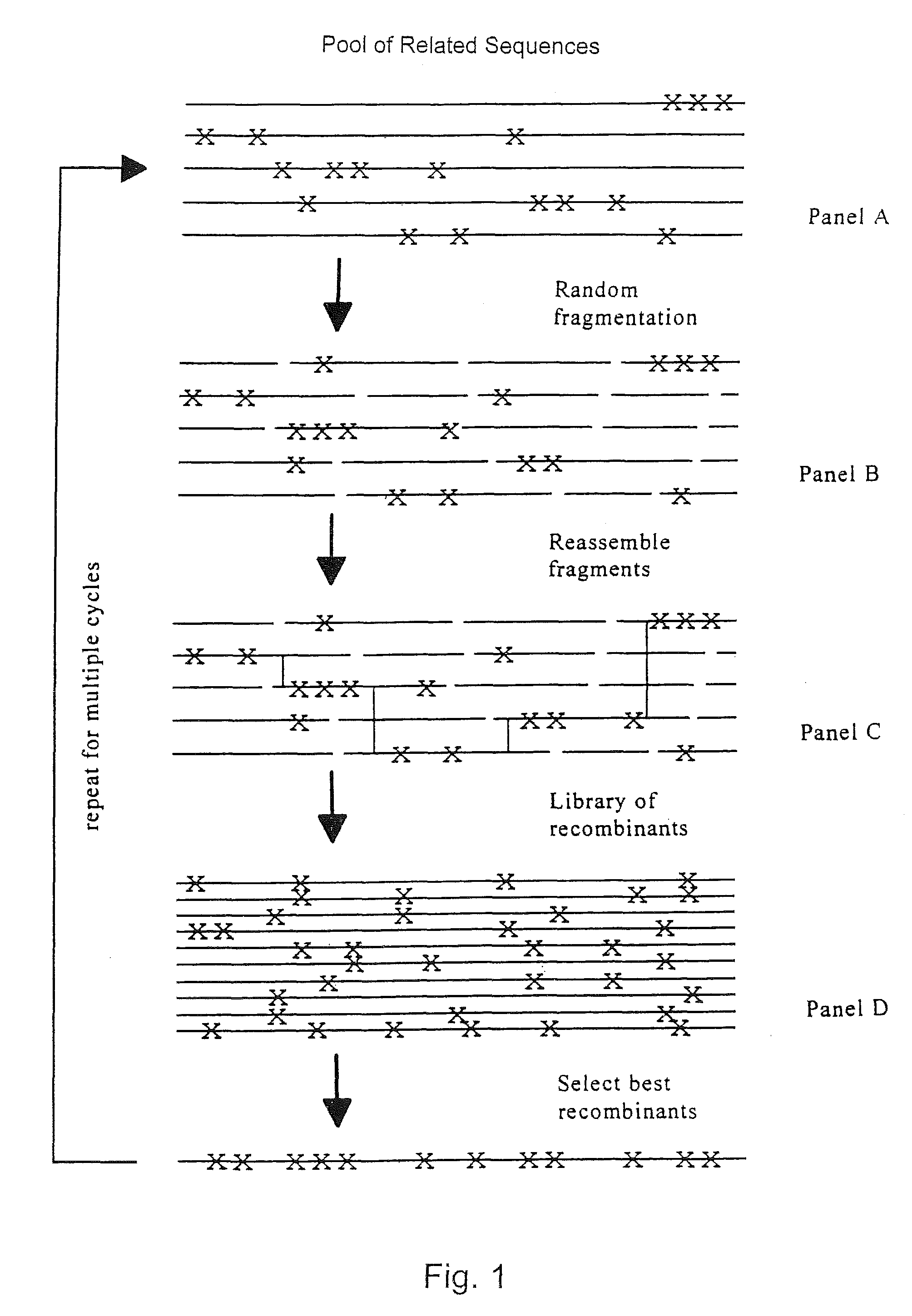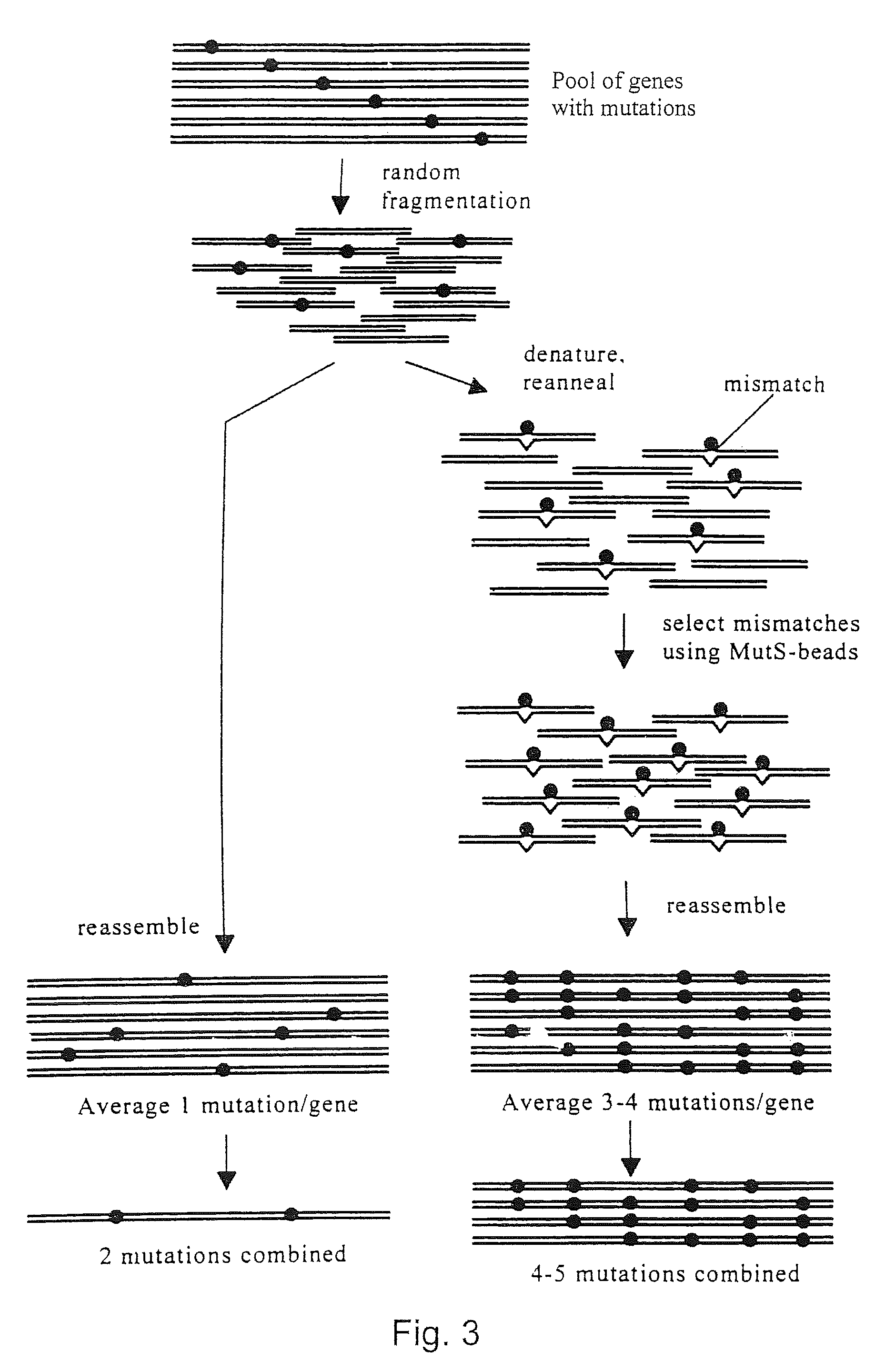Evolution of whole cells and organisms by recursive sequence recombination
a recombination sequence and whole cell technology, applied in the field of molecular genetics, can solve the problems of toxic proteins to the plurality of cells, and achieve the effect of increasing the diversity of any resulting cells and promoting cell regeneration
- Summary
- Abstract
- Description
- Claims
- Application Information
AI Technical Summary
Benefits of technology
Problems solved by technology
Method used
Image
Examples
example 1
JJ. Example 1
Evolving Hyper-Recombinogenic RecA
[0564]RecA protein is implicated in most E. coli homologous recombination pathways. Most mutations in recA inhibit recombination, but some have been reported to increase recombination (Kowalczykowski et al., Microbiol. Rev., 58, 401-465 (1994)). The following example describes evolution of RecA to acquire hyper-recombinogenic activity useful in in vivo shuffling formats.
[0565]Hyperrecombinogenic RecA was selected using a modification of a system developed by Shen et al., Genetics 112, 441-457 (1986); Shen et al., Mol. Gen. Genet. 218, 358-360 (1989)) to measure the effect of substrate length and homology on recombination frequency. Shen & Huang's system used plasmids and bacteriophages with small (31-430 bp) regions of homology at which the two could recombine. In a restrictive host, only phage that had incorporated the plasmid sequence were able to form plaques.
[0566]For shuffling of recA, endogenous recA and mutS were deleted from hos...
example 2
KK. Example 2
Whole Organism Evolution for Hyper-Recombination
[0572]The possibility of selection for an E. coli strain with an increased level of recombination was indicated from phenotypes of wild-type, ΔrecA, mutS and ΔrecA mutS strains following exposure to mitomycin C, an inter-strand cross-linking agent of DNA.
[0573]Exposure of E. coli to mitomycin C causes inter-strand cross-linking of DNA thereby blocking DNA replication. Repair of the inter-strand DNA cross links in E. coli occurs via a RecA-dependent recombinational repair pathway (Friedberg et al., in DNA Repair and Mutagenesis (1995) pp. 191-232). Processing of cross-links during repair results in occasional double-strand DNA breaks, which too are repaired by a RecA-dependent recombinational route. Accordingly, recA− strains are significantly more sensitive than wildtype strains to mitomycin C exposure. In fact, mitomycin C is used in simple disk-sensitivity assays to differentiate between RecA+ and RecA− strains.
[0574]In ...
example 3
LL. Example 3
Whole Genome Shuffling of Streptomyces coelicolor to Improve the Production of Γ-Actinorhodin
[0578]To improve the production of the secondary metabolite γ-actinorhodin from S. coelicolor, the entire genome of this organism is shuffled either alone or with its close relative S. lividans. In the first procedure described below, genetic diversity arises from random mutations generated by chemical or physical means. In the second procedure, genetic diversity arises from the natural diversity existing between the genomes of S. coelicolor and S. lividans.
[0579]Spore suspensions of S. coelicolor are resuspended in sterile water and subjected to UV mutagenesis such that 1% of the spores survive (˜600 “energy” units using a Stratalinker, Stratagene), and the resulting mutants are “grown out” on sporulation agar. Individual spores represent uninucleate cells harboring different mutations within their genome. Spores are collected, washed, and plated on solid medium, preferably so...
PUM
| Property | Measurement | Unit |
|---|---|---|
| pH | aaaaa | aaaaa |
| pH | aaaaa | aaaaa |
| density | aaaaa | aaaaa |
Abstract
Description
Claims
Application Information
 Login to View More
Login to View More - R&D
- Intellectual Property
- Life Sciences
- Materials
- Tech Scout
- Unparalleled Data Quality
- Higher Quality Content
- 60% Fewer Hallucinations
Browse by: Latest US Patents, China's latest patents, Technical Efficacy Thesaurus, Application Domain, Technology Topic, Popular Technical Reports.
© 2025 PatSnap. All rights reserved.Legal|Privacy policy|Modern Slavery Act Transparency Statement|Sitemap|About US| Contact US: help@patsnap.com



